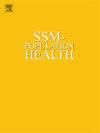The role of sidewalk availability in gentrification: A longitudinal study of U.S. neighborhoods and racial/ethnic composition
IF 3.1
2区 医学
Q1 PUBLIC, ENVIRONMENTAL & OCCUPATIONAL HEALTH
引用次数: 0
Abstract
Introduction
Gentrification may displace lower-income populations, particularly in neighborhoods where the majority of residents identify as Black, Indigenous, and/or People of Color (BIPOC). While the health impacts of gentrification and displacement have been explored, little is known about how pedestrian infrastructure (e.g. sidewalks) may be associated with gentrification. This study assesses whether sidewalk availability is associated with gentrification and changes in BIPOC population, with attention to differences between urban and suburban/small-town contexts where patterns of demographic change may diverge, including potential change in BIPOC population by context.
Methods
Utilizing the Logitudinal Tract Database and U.S. national sidewalk availability, we conducted a longitudinal observational study of 26,498 gentrifiable census tracts limited to urban/suburban/smal town areas across the US in 2010–2020. Sidewalk availability was defined as the proportion of Google Street images within a given census tract that have at least one sidewalk. We used logistic regression to examine the association between sidewalk availability and gentrification and linear regression to assess changes in BIPOC residential composition between 2010 and 2020 in gentrified neighborhoods. Sensitivity and supplementary analysis was conducted for a stratified models by BIPOC thresholds (40 %, 50 %, 60 %) and urban/suburban outcomes.
Results
Sidewalk availability was significantly associated with higher odds of gentrification in all tracts (OR: 1.119; 95 % CI: 1.032–1.212; p = 0.0065) and in BIPOC-majority tracts (OR: 1.216; 95 % CI: 1.088–1.359; p < 0.001). In gentrified neighborhoods, sidewalk availability was associated with a reduction in the percentage of BIPOC residents (−0.016 per 0.1-unit; 95 % CI: −0.027, −0.006; p < 0.002) and a significant decline in the absolute number of BIPOC individuals (−81.2; 95 % CI: −114.78, −47.69; p < 0.001). Supplementary analyses indicated divergence by context: in urban gentrified tracts, each 0.1-unit higher sidewalk availability was associated with −0.020 percentage points in BIPOC share (95 % CI –126.5, −57.2; p < 0.001) and −91.86 BIPOC residents (95 % CI −126.51, −57.22; p < 0.001); in suburban/small-town gentrified tracts, it was associated with +0.036 percentage points (95 % CI: 0.001, 0.071; p = 0.042) and +165 BIPOC residents (95 % CI 45.1, 285.8; p = 0.007).
Conclusion
Our results demonstrate a consistent relationship between sidewalk availability and gentrification, although different associations with BIPOC population change by context, contributing to the ongoing discourse on gentrification, urban development, and neighborhood change.
人行道可用性在高档化中的作用:美国社区和种族/民族构成的纵向研究
中产阶级化可能会取代低收入人口,特别是在大多数居民认为是黑人、土著和/或有色人种(BIPOC)的社区。虽然已经探索了高档化和流离失所对健康的影响,但对行人基础设施(例如人行道)如何与高档化联系在一起知之甚少。本研究评估了人行道的可用性是否与高档化和BIPOC人口的变化有关,并关注了城市和郊区/小城镇背景之间的差异,其中人口变化模式可能存在差异,包括BIPOC人口的潜在变化。方法利用美国全国人行道可用性数据库,对2010-2020年美国城市/郊区/小城镇地区的26,498个可士绅化人口普查区进行了纵向观察研究。人行道可用性定义为在给定的人口普查区内至少有一个人行道的100张街道图像的比例。我们使用逻辑回归来检验人行道可用性与高绅化之间的关系,并使用线性回归来评估2010年至2020年高绅化社区BIPOC住宅组成的变化。通过BIPOC阈值(40%、50%、60%)和城市/郊区结果对分层模型进行敏感性和补充分析。结果:人行道的可用性与高绅化的几率显著相关(OR: 1.119; 95% CI: 1.032-1.212; p = 0.0065),在bipoc占多数的地区(OR: 1.216; 95% CI: 1.088-1.359; p < 0.001)。在高绅化社区,人行道的可用性与BIPOC居民百分比的减少(- 0.016 / 0.1单位;95% CI: - 0.027, - 0.006; p < 0.002)和BIPOC个人绝对数量的显著下降(- 81.2;95% CI: - 114.78, - 47.69; p < 0.001)有关。补充分析显示了环境差异:在城市高绅化地区,每增加0.1个单位的人行道可用性,BIPOC份额就会增加- 0.020个百分点(95% CI -126.5, - 57.2; p < 0.001), BIPOC居民的比例就会增加- 91.86个百分点(95% CI - 126.51, - 57.22; p < 0.001);在郊区/小城镇中产阶级化地区,这与+0.036个百分点(95% CI: 0.001, 0.071; p = 0.042)和+165个BIPOC居民(95% CI 45.1, 285.8; p = 0.007)相关。我们的研究结果表明,人行道可用性与高档化之间存在一致的关系,尽管与BIPOC人口变化之间存在不同的关联,这为高档化、城市发展和社区变化的持续讨论做出了贡献。
本文章由计算机程序翻译,如有差异,请以英文原文为准。
求助全文
约1分钟内获得全文
求助全文
来源期刊

Ssm-Population Health
PUBLIC, ENVIRONMENTAL & OCCUPATIONAL HEALTH-
CiteScore
6.50
自引率
2.10%
发文量
298
审稿时长
101 days
期刊介绍:
SSM - Population Health. The new online only, open access, peer reviewed journal in all areas relating Social Science research to population health. SSM - Population Health shares the same Editors-in Chief and general approach to manuscripts as its sister journal, Social Science & Medicine. The journal takes a broad approach to the field especially welcoming interdisciplinary papers from across the Social Sciences and allied areas. SSM - Population Health offers an alternative outlet for work which might not be considered, or is classed as ''out of scope'' elsewhere, and prioritizes fast peer review and publication to the benefit of authors and readers. The journal welcomes all types of paper from traditional primary research articles, replication studies, short communications, methodological studies, instrument validation, opinion pieces, literature reviews, etc. SSM - Population Health also offers the opportunity to publish special issues or sections to reflect current interest and research in topical or developing areas. The journal fully supports authors wanting to present their research in an innovative fashion though the use of multimedia formats.
 求助内容:
求助内容: 应助结果提醒方式:
应助结果提醒方式:


